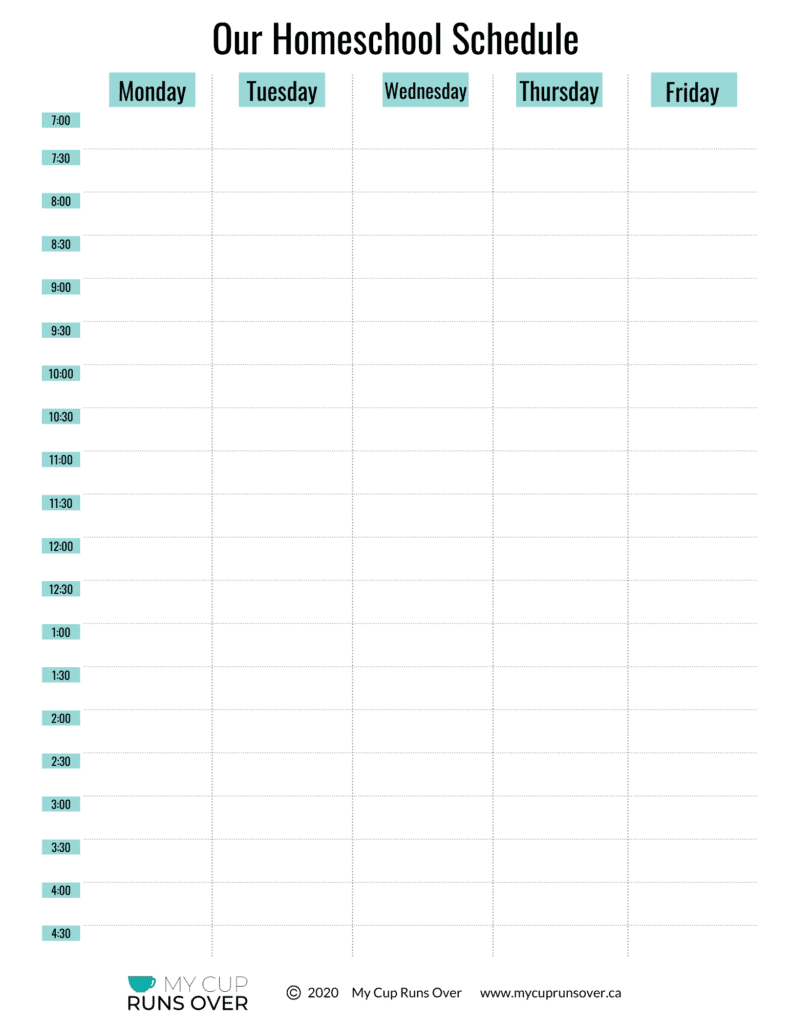Not sure what to do with your first grade homeschooler all day? Looking for a first grade homeschool schedule template?
Whether you’re kicking off your first year of homeschooling or you’re ready for a mid-year restart, this post will walk you through everything you need to consider when creating a daily homeschooling schedule for first grade. At the end, you’ll find examples and templates you can use to get started now.

Disclaimer: I am a Sonlight Ambassador, which means I receive complimentary Sonlight curriculum in exchange for sharing about our experiences as a Sonlight family. All opinions are my own. Learn more.
This post may also include affiliate links, which means My Cup Runs Over earns a commission on any purchases made.
Whether you’re new to homeschooling or just new to homeschooling your first grader, figuring out how to set up your daily homeschool schedule can be challenging.
Perhaps you set out to replicate the kind of experience your child would have in the classroom, or maybe you’ve found yourself caught between conflicting pieces of well-intentioned advice such as “let them play all day” and “a routine is an absolute must.”
Like many homeschoolers–newbies and veterans alike–you may have kicked off the year with a carefully crafted schedule only to find yourself pulling your hair out a couple months in because it’s just. not. working.
Or maybe you just have no idea where to even start.
That’s perfectly normal.
Your first grade homeschool schedule should be a fluid entity, something you’re open to adapting as often as necessary. Because even the best laid plans need to evolve.
The number of factors contributing to the success of your daily schedule necessitates a trial-and-error approach, trying new strategies until you hit on the routine that works best for your 1st grader. (And keeping in mind that what works this month might not work as well a few months down the road!)
In this post, I’ll cover the factors you need to consider when creating your daily homeschool schedule for first grade, as well as a few sample schedule templates.
What to Consider When Planning Your 1st Grade Homeschool Schedule
Before you jump into any kind of schedule, it’s important to remember that there are many different ways to homeschool.
Some families prefer to have no schedule at all, and just follow their interests and passions throughout the day. Others prefer a rigorous schedule where every hour of the day is planned. And most of us fall somewhere in between.

It’s totally up to you to determine what works best for your family, but here are a few things you should take into consideration.
Requirements of your state or province
Each state and province (in the US and Canada, anyway) has its own legislation around homeschooling, and it’s a good idea to check in with that to see what is required of you.
Some jurisdictions are quite open-ended about what your life as a homeschooler should look like, and others are more particular.
You may be expected to prove that you provided formal education to your children for a minimum number of hours and/or days throughout the year. You may also need to provide evidence of the content you covered and ensure you’re teaching all of the required subjects.
So, even if your natural inclination is to be schedule-free, having at least some basic outline of your day and the content you’re covering is going to save you a lot of headaches when it comes time to report on your progress.
Take some time to learn more about the homeschool laws in your state or province.
Subjects and Curriculum
Before making your schedule, you’ll also need to know what subjects you plan to teach and which curriculum (either professional or home-designed) you will use with your first grader.
For example, in my province, first grade students are expected to study applied design skills and technologies, art, basic career education, English language arts, math, P.E., science, and social studies. Your state or province might expect you to cover different subjects.
In addition, your child will probably have extracurricular activities they want to pursue during and after traditional school hours, or you may be part of a homeschool coop that covers some or all of these subjects for you.
Now, in first grade (and many higher level grades too), most homeschooling families choose to get creative about combining subjects wherever possible. For example, you may read and study a poem together, and your discussion of and extended activities relating to that poem might check boxes not only in language arts, but also in math, science, fine arts, or social studies.

The more you’re able to combine subjects from the same source material, the less stressful your first grade homeschool schedule is going to be.
With regards to curriculum, you can either make your own, or you can immerse yourself in the addictive and inspiring world of curriculum purchasing.
When my oldest set of kids were starting out, I purchased very little curriculum. We were registered with a distributed learning school that provided lots of creative activities for us to do, and we didn’t feel the need for a lot of formal curriculum packages.
However, as those kids have gotten older and as we welcomed a second set of kids into the family, I have leaned much more heavily on purchased curriculum.
One of the challenges with creating your own curriculum is that developing lesson plans and sourcing materials can be very time-consuming. Some parents are naturally gifted at this and love to spend their late night hours coming up with creative plans for their kids.
Unfortunately, I don’t think I got that gift, and with four active kids demanding my attention constantly, I rarely have time to come up with my own lesson plans.
That’s one reason our family uses Sonlight curriculum to cover social studies, geography, history, science, Bible, and most of our language arts. All of the books we need for our lessons are carefully selected for me and are ready to go at a moment’s notice when we’re ready to read them, and our lesson plans have been thoughtfully planned out for us.

They’re not overly restrictive like some other lesson plans I’ve used, where parents and children are expected to follow some kind of script as they work through the lessons. Rather, they give parents enough background information and suggestions that we can just jump in without any prep work and keep up with our lightning fast children.
The schedule is also open-and-go, so if I block out a section of time in our day for Sonlight, I just have to open my binder and follow each of the tasks laid out for the day.
This is a huge timesaver when I’m trying to squeeze lessons in between meals, science labs, and driving to dance classes.
Your goals and homeschooling style
In creating a schedule that works for you, it’s also important to keep in mind your goals and style as a homeschooling family.
Are you working on socializing your kids more? Recovering from a bad experience in the school system? Focusing on developing introductory reading skills? Assessing for a learning disorder?
Each child has unique needs, and one of the greatest benefits of homeschooling is your ability to address your children’s needs. Your homeschool schedule should reflect this.
If your child was in school and had to be pulled out, for example, give them time to just be home and recover from that experience. Don’t jump right into a crazy schedule from day one.
No six year old is going to get behind by having a few days, weeks, or even months of unstructured learning.
But when you are ready to create a bit more of a schedule, consider your homeschooling style. Do you want to provide a classical education? Do you prefer the Charlotte Mason style where you spend lots of time reading, doing art, and exploring nature?
Your homeschool schedule should also take this into account.

Tracking and monitoring your homeschool schedule: how will you know what and when to adjust?
As mentioned earlier, your homeschool schedule is not a set-it-and-forget it kind of thing. You will need to come back to it frequently and make sure it’s working for you and your kids.
Here are some reasons why your schedule might need to be updated:
- You’re feeling burnt out and finding it hard to keep up.
- You want to add in or take out one or more of your family’s activities.
- You’d like to change the curriculum you’re using.
- There’s a change in your home, like a new pet or a new baby.
- You fell off track and need a way to ease back into your routine.
Plan ahead to regularly evaluate your schedule so you can keep things running smoothly in your homeschool. Instead of a problem creeping up on you and causing overwhelm, you can catch simmering issues before they boil over and stir things up.
What to include in your daily homeschooling schedule
In addition to the subjects mentioned earlier (or those required by your jurisdiction), there are several other things you’ll want to make room for you in your schedule.
These include:
- Field trips (both formal, like to a museum, and informal, such as the library)
- Time to do tasks and chores around the house
- Hands-on activities (Our Sonlight curriculum comes with some awesome hands-on history activities and science labs, and they take precedence in my first grader’s mind about what should be on her schedule!)
- Games (learning through games is one of the best opportunities homeschooling offers)
- Social visits (necessary for both the kids and the teacher’s sanity!)
- Coops or other community-based classes
- Lessons outside of the home (dance, martial arts, hockey, baseball, art, music, 4H, Brownies/Girl Guides/Scouts, etc.)
- Free exploration time

How to Make a Homeschool Schedule
There are lots of different options for how you actually create your schedule and display it in your home. Over the years, I’ve tried dozens of options: planners, Google calendar (digital + print out), daily posters, whiteboards, chalkboards, big signs, little signs, one sign, two signs, red signs, blue signs.
There is no right or wrong way to organize and display your schedule, but I do think it’s important to keep your child or children in the loop. I find my kids are much more cooperative when they know what the day looks like.
When they sit down to do their schoolwork at nine, it encourages them to know it won’t go on forever. There’s a break coming at ten fifteen, another one at noon. A quiet reading time after lunch. Free time after three o’clock.
Having these markers set up throughout their day gives them the focus they need to get through the parts they love less.
Examples of Daily Homeschool Schedules
Here are a few examples of how I’ve displayed our schedule in the past. You will see that in previous years, we’ve been very rigid about who does what, when.
This was primarily driven by the need to share a limited number of computers and the need for me to divide my time between several children requiring varying degrees of one-on-one assistance.
Now that my kids are a little older (13, 11, 6, and 3), more of them are able to work independently more of the time. This allows for a bit more flexibility in our schedule.
For example, I can say, “We’re going to work for two hours, and here are the subjects I’d like you to cover in that time. You can choose the order and how you divide that time between the subjects.”
Most of my time is spent working with my first grader or keeping their little brother out of the girls’ way.
For the Techy Homeschool Parent

In Google calendar, I give each child their own color-coded calendar, and the tasks repeat each week. Older children have access to their own calendars through their Gmail accounts, but I also print out this schedule and post it on the fridge each week. (To be extra sure, I also copy the key items that stay the same every week onto a whiteboard on their bedroom wall!)
For the Ultra-Organized Homeschool Parent

For a few years, I used Debra Bell’s Ultimate Homeschool Planner. This is a great resource if you’re new to homeschooling because it has a lot of information about homeschooling in general and setting up your homeschool schedule for success. (By the way, Debra Bell is also the author of one of my all-time favorite homeschooling books).
There is ample room in here for scheduling up to six kids, plus your personal life (which won’t take up much space if you’re a homeschooling parent!)
This option is great if you’re the kind of person who likes to write down everything.
Here are a couple other homeschool planners to check out:
For the relaxed homeschool parent

When we first started homeschooling, my daughters were three and five, and we used a very relaxed homeschooling schedule. Here is the schedule we used in our second year. (Why I’ve kept these papers for seven years, I’m not sure, but I had fun digging them up to show you!)
There were no set times associated with each subject, just a set amount of time to work on each one. I found this worked best because they couldn’t always make it through a whole lesson and I didn’t want them to be stressed out by getting behind. I preferred to have them work at their own pace, even if it took longer to get through the curriculum.
We had some tasks that we did one-one-one, some that they did alone, and some that we did altogether. At those ages, and because of their small age gap, most of what we did was together.

This year, perhaps because of all the craziness, I felt led to return to a simpler method of homeschool scheduling. I think I was longing for those days when we worked at our own pace, got through as much as we could without feeling too stressed, and put more emphasis on the fun stuff like doing art projects and going for walks.
We started homeschooling very late in the fall after spending two months moving and getting settled into our new home, and I drew up this basic homeschool schedule very late on the Sunday night before we began.
I listed the days of the week at the top and the subjects down the side. Beside each subject, I’ve written the initial of each child.
Each morning, when we wake up, we discuss their priorities for the day. We try to keep on track with our academic subjects as much as possible, but sometimes we have to slow down if they’re working through a particularly laborious subject. (This is more for the older kids; my first grader is pretty much able to keep up with everything no problem).
I write down, either in the notebook or on our family chalkboard, which lesson they are to tackle for each subject each day. In the case of our Sonlight curriculum, I just tell them what day they are on, and the Sonlight schedule gives them the list of everything they need to do.
Basic Daily First Grade Homeschool Schedule Template
So, now that you know everything that should be included in your schedule and a few different formats for organizing it, it’s time to develop your own daily first grade homeschool schedule.
I’ve created this example for you, so you can get a sense of what our typical day looks like. Feel free to use it if it works for you.
I’m also including a free homeschool schedule template so you can print it out and make your own.


Hopefully this post has helped you figure out what should go in your first grade homeschool schedule, how to organize it, and how to keep track of it and share it with your family.
If you have any questions about scheduling in your homeschool, teaching first grade, or using Sonlight curriculum, leave them in the comments below.

Sophie Agbonkhese is a writer, homeschooling mother of four, and a recovering overachiever (who occasionally relapses). She is the founder of My Cup Runs Over, a site dedicated to helping busy women simplify and enrich their lives. When she’s not writing or debugging websites, Sophie spends her time reading, dancing, bullet journaling, reading, gardening, listening to audiobooks, and striving fruitlessly to have a clean house for at least five minutes.


Andrea
Sunday 19th of February 2023
This was wonderful, thank you!
SOPHIE AGBONKHESE
Tuesday 28th of February 2023
You're welcome!